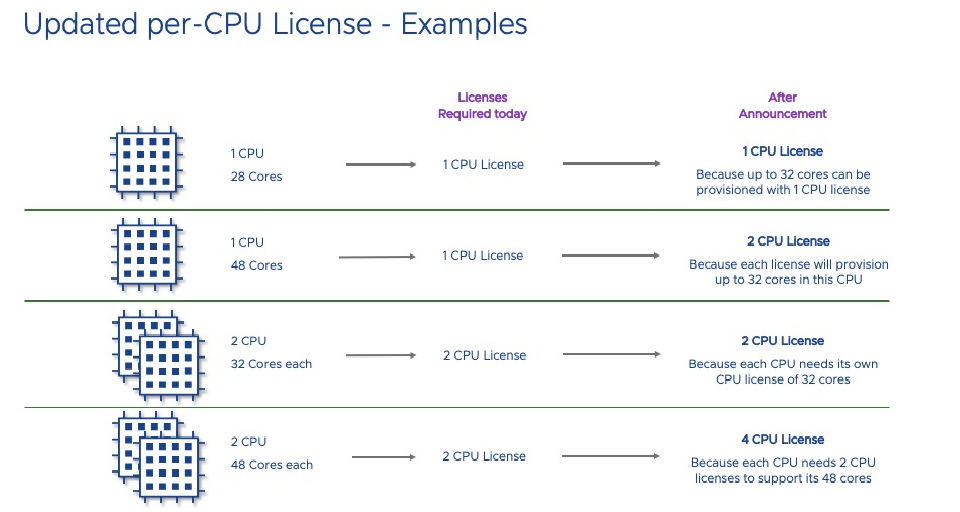Today we announced an important update to our per-CPU pricing model, reflecting our commitment to continue meeting our customers’ needs in an evolving industry landscape. This new pricing model will give our customers greater choice and allow us to better serve them.
While we will still be using a per-CPU approach, now, for any software offering that we license on a per-CPU basis, we will require one license for up to 32 physical cores. If a CPU has more than 32 cores, additional CPU licenses will be required. A FAQ related to this change is below.
Today’s announcement is a continuation of VMware’s journey to align our product offerings to industry standard pricing models. The change moves VMware closer to the current software industry standard model of core-based pricing. This approach will make it easier for customers to compare software licensing and pricing between VMware (using per-CPU with up to 32 cores) and other vendors (using per core pricing). It also helps us keep our pricing simple and relevant to where the hardware market is going.
The 32-core limit is designed to minimize customer impact given current core counts for most CPUs used in the industry. This change will likely have no impact on the vast majority of our current customers since they use Intel and AMD-based servers that are at or below the 32-core threshold. For the few customers who are currently deploying our software on CPUs with more than 32 cores, or for those that are in the process of purchasing physical servers with more than 32 cores per CPU, we are providing a grace period after the licensing metric change goes into effect on April 2, 2020. Any customer who purchases VMware software licenses, for deployment on a physical server with more than 32-cores per CPU, prior to April 30, 2020 will be eligible for additional free per-CPU licenses to cover the CPUs on that server.
Frequently Asked Questions
Q: What is VMware announcing?
A: VMware is more closely aligning to the industry standard of licensing software based on CPU cores as a primary licensing metric. With this change, VMware is still using the per-CPU licensing model, but we will require one license for any software offering that we license on a per-CPU basis, for up to 32 physical cores. That is, the license will cover CPUs with up to 32 physical cores. The updated policy will apply to licenses purchased starting on April 2, 2020, and to existing licenses where customer installs a new release of VMware software on or after April 2, 2020.
Q: Why is VMware updating its per-CPU licensing model?
A: VMware is working to align our product offerings to industry standard licensing models and projected changes in the hardware market. We cannot continue pricing on a per-CPU basis, where CPUs have unlimited core counts. The 32-core limit is designed to minimize customer impact given current core counts generally used in the industry, and by the majority of our customers.
Any customer that purchases VMware software per-CPU licenses, to be deployed on a physical server with more than 32 cores per CPU, prior to April 30, 2020 will be eligible for additional free per-CPU licenses to cover the cores on those CPUs.
Q: How is this change an alignment to industry standards?
A: CPU cores are the main software licensing metric across the industry. Customers today license software from other major software vendors based on CPU cores (that is, on a per-core basis). Because VMware is moving toward this standard metric, it is easier for customers to compare software licensing and pricing between VMware (using per-CPU licenses covering up to 32 cores) and other vendors (using per-core pricing).
Q: What existing VMware products already use CPU cores as the key licensing metric?
A: VMware Enterprise PKS and VMware NSX Data Center subscription are examples of some of the products that use CPU cores as the licensing metric.
Q. Can you help me understand the new model?
A: Under the new model, one CPU license covers up to 32 cores in a single CPU. If the CPU has more than 32 cores, additional (per-CPU) licenses are required. To provide some examples:

Q: What is the process for eligible customers to apply for additional licenses?
A: Customers can raise a ticket via My VMware Portal and include the following information:
- Number of cores per CPU and total number of CPUs
- List of VMware products for which the customer is requesting additional licenses, and number of additional licenses needed for each product
- Proof of Server purchase, number of processor(s) in the server, and number of physical cores per CPU.
Customers will receive a response within 15 business days and additional licenses will be granted after approval.
Q: How many current customers are impacted by this change?
A: The vast majority of the currently installed base of VMware software is deployed on existing Intel and AMD-based servers that are at or below the 32-core threshold. Any current customers that purchase VMware software licenses, to be deployed on a physical server with more than 32-cores per CPU, prior to April 30, 2020 will be eligible for additional free per-CPU licenses to cover the CPUs on that server.
Q: What are the terms and conditions for customers who apply for additional free licenses to support deployments of VMware software on CPUs with more than 32 cores?
A: To be eligible:
- Servers and VMware licenses must be purchased before 11:59 pm PST U.S. April 30, 2020
- The request for additional licenses must be submitted before 11:59pm PST U.S. on January 29, 2021. Proof of server purchase prior to April 30, 2020 will be required
- Customers must be on active VMware support (SnS) contracts at the time of the request for additional licenses.
- Note that customers will be charged for Service and Support on the additional free licenses at the time the customer’s Service and Support contract for the existing licenses renews.
Q: How does multithreading (e.g. Hyperthreading) impact the core count in a CPU?
A: Multithreading does not impact the core count for the purposes of VMware per-CPU licensing. Instead, core count is based solely on the number of physical cores of the individual CPU.
Q: How does the new licensing policy impact customers with unlimited ELA?
A: There is no impact for customers with unlimited ELAs during the term of the ELA.
Q: What happens to customers that have purchased HPP/EPP credits and still have an outstanding balance of unredeemed credits?
A: The new licensing policy is applicable to customers with unredeemed HPP/EPP credits. Any customers that redeem HPP/EPP credits for VMware software per-CPU licenses, to be deployed on a physical server with more than 32-cores per CPU, prior to April 30, 2020 will be eligible for additional free per-CPU licenses.
Q: What qualifies as acceptable proof for additional license request?
A: In general, an invoice or any reasonable proof that includes the server purchase date, number of processor(s) in the server, and number of physical cores per CPU will be sufficient. Customers can submit the ticket via My VMware Portal, and VMware will review requests on a case by case basis.
Q: Which products are impacted by this new licensing policy?
A: The updated definition of per-CPU licenses will impact all VMware offerings using per-CPU as the licensing metric.
Here is a partial list of products impacted by the new licensing policy:
- VMware Cloud Foundation
- VMware Enterprise PKS
- VMware EVO:RAIL General Purpose Suite
- VMware HCI Kit
- VMware HCX
- VMware Integrated OpenStack
- VMware NSX Data Center
- VMware SDDC Manager
- VMware Site Recovery Manager
- VMware vCenter Site Recovery Manager
- VMware vCloud Director
- VMware vCloud NFV Bundle
- VMware vCloud NFV OpenStack Bundle
- VMware vCloud Suite
- VMware vRealize Automation
- VMware vRealize Code Stream
- VMware vRealize Network Insight
- VMware vRealize Suite
- VMware vRealize Log Insight
- VMware vSAN
- VMware vSphere
- VMware vRealize Operations Manager
- vRealize Business
- vRealize Hyperic

